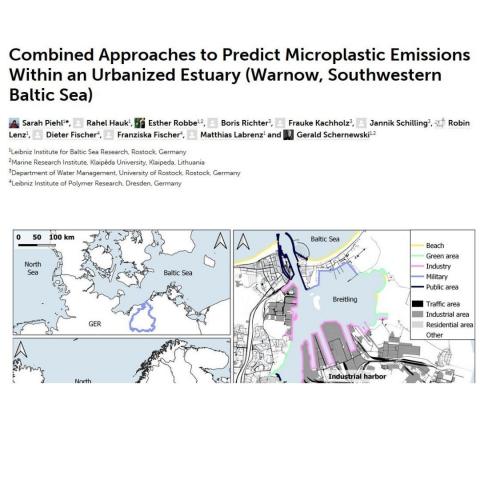Combined Approaches to Predict Microplastic Emissions Within an Urbanized Estuary (Warnow, Southwestern Baltic Sea)
Combined Approaches to Predict Microplastic Emissions Within an Urbanized Estuary (Warnow, Southwestern Baltic Sea)
Abstract: Microplastic river emissions are known to be one of the major sources for marine microplastic pollution. Especially urbanized estuaries localized at the land-sea interface and subjected to microplastic emissions from various sources exhibit a high microplastic discharge potential to adjacent coasts. To adapt effective measures against microplastic emissions a more detailed knowledge on the importance of various microplastic sources is necessary. As field data is scarce we combined different approaches to assess microplastic emissions into the Warnow estuary, southwestern Baltic Sea. Resulting microplastic emission estimates are based on in-situ measurements for the catchment emissions, whereas for the remaining microplastic sources within the estuary literature data on microplastic abundances, and various parameters were used (e.g. demographical, hydrological, geographical). The evaluation of the different emission scenarios revealed that the majority of microplastic is likely discharged by the Warnow river catchment (49.4%) and the separated city stormwater system (43.1%) into the estuary, followed by combined sewer discharges (6.1%). Wastewater treatment plant emissions exhibit the lowest percentage (1.4%). Our approach to estimate anti-fouling paint particles emissions from leisure and commercial shipping activities was associated with highest uncertainties. However, our results indicate the importance of this source highlighting the necessity for future research on the topic. Based on our assumptions for microplastic retention within the estuary, we estimate a potential annual emission of 152–291 billion microplastics (majority within the size class 10–100 µm) to the Baltic Sea. Considering all uncertainties of the different applied approaches, we could assess the importance of various microplastic sources which can be used by authorities to prioritize and establish emission reduction measures. Additionally, the study provides parameters for microplastic emission estimates that can be transferred from our model system to other urbanized Baltic estuaries.
Piehl S, Hauk R, Robbe E, Richter B, Kachholz F, Schilling J, Lenz R, Fischer D, Fischer F, Labrenz M and Schernewski G (2021) Combined Approaches to Predict Microplastic Emissions Within an Urbanized Estuary (Warnow, Southwestern Baltic Sea). Front. Environ. Sci. 9:616765. doi: 10.3389/fenvs.2021.616765

